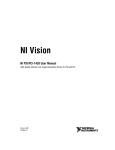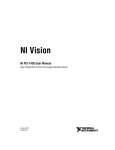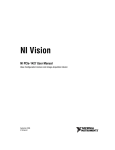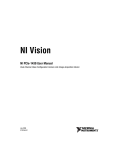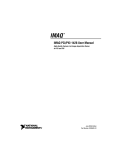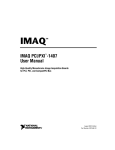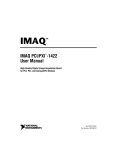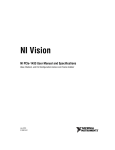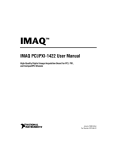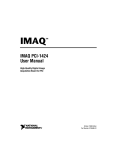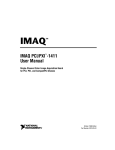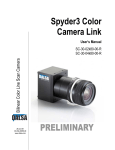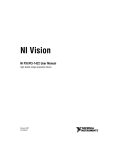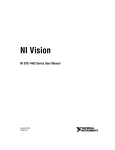Download IMAQ PCI-1428 User Manual
Transcript
IMAQ ™ IMAQ PCI-1428 User Manual High-Quality Camera Link Image Acquisition Device for PCI IMAQ PCI-1428 User Manual January 2002 Edition Part Number 322862B-01 Support Worldwide Technical Support and Product Information ni.com National Instruments Corporate Headquarters 11500 North Mopac Expressway Austin, Texas 78759-3504 USA Tel: 512 683 0100 Worldwide Offices Australia 03 9879 5166, Austria 0662 45 79 90 0, Belgium 02 757 00 20, Brazil 011 3262 3599, Canada (Calgary) 403 274 9391, Canada (Montreal) 514 288 5722, Canada (Ottawa) 613 233 5949, Canada (Québec) 514 694 8521, Canada (Toronto) 905 785 0085, China (Shanghai) 021 6555 7838, China (ShenZhen) 0755 3904939, Czech Republic 02 2423 5774, Denmark 45 76 26 00, Finland 09 725 725 11, France 01 48 14 24 24, Germany 089 741 31 30, Greece 30 1 42 96 427, Hong Kong 2645 3186, India 91 80 535 5406, Israel 03 6393737, Italy 02 413091, Japan 03 5472 2970, Korea 02 3451 3400, Malaysia 603 9596711, Mexico 001 800 010 0793, Netherlands 0348 433466, New Zealand 09 914 0488, Norway 32 27 73 00, Poland 0 22 528 94 06, Portugal 351 210 311 210, Russia 095 238 7139, Singapore 2265886, Slovenia 386 3 425 4200, South Africa 11 805 8197, Spain 91 640 0085, Sweden 08 587 895 00, Switzerland 056 200 51 51, Taiwan 02 2528 7227, United Kingdom 01635 523545 For further support information, see the Technical Support Resources appendix. To comment on the documentation, send e-mail to [email protected]. © 2001, 2002 National Instruments Corporation. All rights reserved. Important Information Warranty The IMAQ PCI-1428 is warranted against defects in materials and workmanship for a period of one year from the date of shipment, as evidenced by receipts or other documentation. National Instruments will, at its option, repair or replace equipment that proves to be defective during the warranty period. This warranty includes parts and labor. The media on which you receive National Instruments software are warranted not to fail to execute programming instructions, due to defects in materials and workmanship, for a period of 90 days from date of shipment, as evidenced by receipts or other documentation. National Instruments will, at its option, repair or replace software media that do not execute programming instructions if National Instruments receives notice of such defects during the warranty period. National Instruments does not warrant that the operation of the software shall be uninterrupted or error free. A Return Material Authorization (RMA) number must be obtained from the factory and clearly marked on the outside of the package before any equipment will be accepted for warranty work. National Instruments will pay the shipping costs of returning to the owner parts which are covered by warranty. National Instruments believes that the information in this document is accurate. The document has been carefully reviewed for technical accuracy. In the event that technical or typographical errors exist, National Instruments reserves the right to make changes to subsequent editions of this document without prior notice to holders of this edition. The reader should consult National Instruments if errors are suspected. In no event shall National Instruments be liable for any damages arising out of or related to this document or the information contained in it. EXCEPT AS SPECIFIED HEREIN, NATIONAL INSTRUMENTS MAKES NO WARRANTIES , EXPRESS OR IMPLIED, AND SPECIFICALLY DISCLAIMS ANY WARRANTY OF MERCHANTABILITY OR FITNESS FOR A PARTICULAR PURPOSE . C USTOMER’S RIGHT TO RECOVER DAMAGES CAUSED BY FAULT OR NEGLIGENCE ON THE PART OF NATIONAL INSTRUMENTS SHALL BE LIMITED TO THE AMOUNT THERETOFORE PAID BY THE CUSTOMER. NATIONAL INSTRUMENTS WILL NOT BE LIABLE FOR DAMAGES RESULTING FROM LOSS OF DATA, PROFITS, USE OF PRODUCTS, OR INCIDENTAL OR CONSEQUENTIAL DAMAGES, EVEN IF ADVISED OF THE POSSIBILITY THEREOF. This limitation of the liability of National Instruments will apply regardless of the form of action, whether in contract or tort, including negligence. Any action against National Instruments must be brought within one year after the cause of action accrues. National Instruments shall not be liable for any delay in performance due to causes beyond its reasonable control. The warranty provided herein does not cover damages, defects, malfunctions, or service failures caused by owner’s failure to follow the National Instruments installation, operation, or maintenance instructions; owner’s modification of the product; owner’s abuse, misuse, or negligent acts; and power failure or surges, fire, flood, accident, actions of third parties, or other events outside reasonable control. Copyright Under the copyright laws, this publication may not be reproduced or transmitted in any form, electronic or mechanical, including photocopying, recording, storing in an information retrieval system, or translating, in whole or in part, without the prior written consent of National Instruments Corporation. Trademarks CVI™, IMAQ™ , LabVIEW™, Measurement Studio™ , National Instruments™, and ni.com™ are trademarks of National Instruments Corporation. Product and company names mentioned herein are trademarks or trade names of their respective companies. Patents For patents covering National Instruments products, refer to the appropriate location: Help»Patents in your software, the patents.txt file on your CD, or ni.com/patents. WARNING REGARDING USE OF NATIONAL INSTRUMENTS PRODUCTS (1) NATIONAL INSTRUMENTS PRODUCTS ARE NOT DESIGNED WITH COMPONENTS AND TESTING FOR A LEVEL OF RELIABILITY SUITABLE FOR USE IN OR IN CONNECTION WITH SURGICAL IMPLANTS OR AS CRITICAL COMPONENTS IN ANY LIFE SUPPORT SYSTEMS WHOSE FAILURE TO PERFORM CAN REASONABLY BE EXPECTED TO CAUSE SIGNIFICANT INJURY TO A HUMAN. (2) IN ANY APPLICATION, INCLUDING THE ABOVE, RELIABILITY OF OPERATION OF THE SOFTWARE PRODUCTS CAN BE IMPAIRED BY ADVERSE FACTORS, INCLUDING BUT NOT LIMITED TO FLUCTUATIONS IN ELECTRICAL POWER SUPPLY, COMPUTER HARDWARE MALFUNCTIONS, COMPUTER OPERATING SYSTEM SOFTWARE FITNESS, FITNESS OF COMPILERS AND DEVELOPMENT SOFTWARE USED TO DEVELOP AN APPLICATION, INSTALLATION ERRORS, SOFTWARE AND HARDWARE COMPATIBILITY PROBLEMS, MALFUNCTIONS OR FAILURES OF ELECTRONIC MONITORING OR CONTROL DEVICES, TRANSIENT FAILURES OF ELECTRONIC SYSTEMS (HARDWARE AND/OR SOFTWARE), UNANTICIPATED USES OR MISUSES, OR ERRORS ON THE PART OF THE USER OR APPLICATIONS DESIGNER (ADVERSE FACTORS SUCH AS THESE ARE HEREAFTER COLLECTIVELY TERMED “SYSTEM FAILURES”). ANY APPLICATION WHERE A SYSTEM FAILURE WOULD CREATE A RISK OF HARM TO PROPERTY OR PERSONS (INCLUDING THE RISK OF BODILY INJURY AND DEATH) SHOULD NOT BE RELIANT SOLELY UPON ONE FORM OF ELECTRONIC SYSTEM DUE TO THE RISK OF SYSTEM FAILURE. TO AVOID DAMAGE, INJURY, OR DEATH, THE USER OR APPLICATION DESIGNER MUST TAKE REASONABLY PRUDENT STEPS TO PROTECT AGAINST SYSTEM FAILURES, INCLUDING BUT NOT LIMITED TO BACK-UP OR SHUT DOWN MECHANISMS. BECAUSE EACH END-USER SYSTEM IS CUSTOMIZED AND DIFFERS FROM NATIONAL INSTRUMENTS' TESTING PLATFORMS AND BECAUSE A USER OR APPLICATION DESIGNER MAY USE NATIONAL INSTRUMENTS PRODUCTS IN COMBINATION WITH OTHER PRODUCTS IN A MANNER NOT EVALUATED OR CONTEMPLATED BY NATIONAL INSTRUMENTS, THE USER OR APPLICATION DESIGNER IS ULTIMATELY RESPONSIBLE FOR VERIFYING AND VALIDATING THE SUITABILITY OF NATIONAL INSTRUMENTS PRODUCTS WHENEVER NATIONAL INSTRUMENTS PRODUCTS ARE INCORPORATED IN A SYSTEM OR APPLICATION, INCLUDING, WITHOUT LIMITATION, THE APPROPRIATE DESIGN, PROCESS AND SAFETY LEVEL OF SUCH SYSTEM OR APPLICATION. Compliance FCC/Canada Radio Frequency Interference Compliance* Determining FCC Class The Federal Communications Commission (FCC) has rules to protect wireless communications from interference. The FCC places digital electronics into two classes. These classes are known as Class A (for use in industrial-commercial locations only) or Class B (for use in residential or commercial locations). Depending on where it is operated, this product could be subject to restrictions in the FCC rules. (In Canada, the Department of Communications (DOC), of Industry Canada, regulates wireless interference in much the same way.) Digital electronics emit weak signals during normal operation that can affect radio, television, or other wireless products. By examining the product you purchased, you can determine the FCC Class and therefore which of the two FCC/DOC Warnings apply in the following sections. (Some products may not be labeled at all for FCC; if so, the reader should then assume these are Class A devices.) FCC Class A products only display a simple warning statement of one paragraph in length regarding interference and undesired operation. Most of our products are FCC Class A. The FCC rules have restrictions regarding the locations where FCC Class A products can be operated. FCC Class B products display either a FCC ID code, starting with the letters EXN, or the FCC Class B compliance mark that appears as shown here on the right. Consult the FCC Web site http://www.fcc.gov for more information. FCC/DOC Warnings This equipment generates and uses radio frequency energy and, if not installed and used in strict accordance with the instructions in this manual and the CE Mark Declaration of Conformity**, may cause interference to radio and television reception. Classification requirements are the same for the Federal Communications Commission (FCC) and the Canadian Department of Communications (DOC). Changes or modifications not expressly approved by National Instruments could void the user’s authority to operate the equipment under the FCC Rules. Class A Federal Communications Commission This equipment has been tested and found to comply with the limits for a Class A digital device, pursuant to part 15 of the FCC Rules. These limits are designed to provide reasonable protection against harmful interference when the equipment is operated in a commercial environment. This equipment generates, uses, and can radiate radio frequency energy and, if not installed and used in accordance with the instruction manual, may cause harmful interference to radio communications. Operation of this equipment in a residential area is likely to cause harmful interference in which case the user will be required to correct the interference at his own expense. Canadian Department of Communications This Class A digital apparatus meets all requirements of the Canadian Interference-Causing Equipment Regulations. Cet appareil numérique de la classe A respecte toutes les exigences du Règlement sur le matériel brouilleur du Canada. Class B Federal Communications Commission This equipment has been tested and found to comply with the limits for a Class B digital device, pursuant to part 15 of the FCC Rules. These limits are designed to provide reasonable protection against harmful interference in a residential installation. This equipment generates, uses and can radiate radio frequency energy and, if not installed and used in accordance with the instructions, may cause harmful interference to radio communications. However, there is no guarantee that interference will not occur in a particular installation. If this equipment does cause harmful interference to radio or television reception, which can be determined by turning the equipment off and on, the user is encouraged to try to correct the interference by one or more of the following measures: • Reorient or relocate the receiving antenna. • Increase the separation between the equipment and receiver. • Connect the equipment into an outlet on a circuit different from that to which the receiver is connected. • Consult the dealer or an experienced radio/TV technician for help. Canadian Department of Communications This Class B digital apparatus meets all requirements of the Canadian Interference-Causing Equipment Regulations. Cet appareil numérique de la classe B respecte toutes les exigences du Règlement sur le matériel brouilleur du Canada. European Union - Compliance to EEC Directives Readers in the EU/EEC/EEA must refer to the Manufacturer's Declaration of Conformity (DoC) for information** pertaining to the CE Mark compliance scheme. The Manufacturer includes a DoC for most every hardware product except for those bought for OEMs, if also available from an original manufacturer that also markets in the EU, or where compliance is not required as for electrically benign apparatus or cables. * Certain exemptions may apply in the USA, see FCC Rules §15.103 Exempted devices, and §15.105(c). Also available in sections of CFR 47. ** The CE Mark Declaration of Conformity will contain important supplementary information and instructions for the user or installer. Conventions This manual uses the following conventions: <> Angle brackets that contain numbers separated by an ellipsis represent a range of values associated with a bit or signal name—for example, DBIO<3..0>. » The » symbol leads you through nested menu items and dialog box options to a final action. The sequence File»Page Setup»Options directs you to pull down the File menu, select the Page Setup item, and select Options from the last dialog box. This icon denotes a note, which alerts you to important information. This icon denotes a caution, which advises you of precautions to take to avoid injury, data loss, or a system crash. bold Bold text denotes items that you must select or click on in the software, such as menu items and dialog-box options. Bold text also denotes parameter names. italic Italic text denotes variables, emphasis, a cross reference, or an introduction to a key concept. This font also denotes text that is a placeholder for a word or value that you must supply. monospace Text in this font denotes text or characters that you should enter from the keyboard, sections of code, programming examples, and syntax examples. This font is also used for the proper names of disk drives, paths, directories, programs, subprograms, subroutines, device names, functions, operations, variables, filenames and extensions, and code excerpts. Contents Chapter 1 Introduction About the IMAQ PCI-1428 ...........................................................................................1-1 Camera Link ..................................................................................................................1-2 Overview .........................................................................................................1-2 Interfacing with the PCI-1428 .......................................................................................1-2 Software Programming Choices ....................................................................................1-3 NI-IMAQ Driver Software ..............................................................................1-5 National Instruments IMAQ Vision ................................................................1-6 IMAQ Vision Builder......................................................................................1-6 Integration with DAQ......................................................................................1-7 Vision and Motion ...........................................................................................1-7 Chapter 2 Installation What You Need to Get Started ......................................................................................2-1 Optional Equipment .......................................................................................................2-2 Setting up Your IMAQ System .....................................................................................2-2 Unpacking ......................................................................................................................2-4 Safety Information .........................................................................................................2-4 Installation .....................................................................................................................2-6 Configuring the PCI-1428 .............................................................................................2-7 Chapter 3 Hardware Overview Functional Overview......................................................................................................3-1 Camera Link and PCI-1428.............................................................................3-2 Base Configuration ...........................................................................3-2 Medium Configuration......................................................................3-3 Data Transmission ...........................................................................................3-3 LUTs................................................................................................................3-3 Multiple-Tap Data Formatter ..........................................................................3-4 SDRAM...........................................................................................................3-4 Trigger Control and Mapping Circuitry ..........................................................3-4 High-Speed Timing .........................................................................................3-4 Acquisition, Scaling, ROI................................................................................3-5 Scatter-Gather DMA Controllers ....................................................................3-5 Bus Master PCI Interface ................................................................................3-5 © National Instruments Corporation vii IMAQ PCI-1428 User Manual Contents Start Conditions............................................................................................... 3-5 Acquisition Window Control .......................................................................... 3-6 Serial Interface ................................................................................................ 3-6 Chapter 4 Signal Connections Connectors..................................................................................................................... 4-1 MDR 26-Pin Connector .................................................................................. 4-2 68-Pin VHDCI Connector............................................................................... 4-2 Connector Signal Connection Descriptions .................................................... 4-3 Appendix A Specifications Appendix B Cabling Appendix C Technical Support Resources Glossary Index IMAQ PCI-1428 User Manual viii ni.com 1 Introduction This chapter provides an overview of the PCI-1428 image acquisition device, the Camera Link standard, Camera Link/PCI-1428 interfacing guidelines, and your software programming choices. About the IMAQ PCI-1428 The PCI-1428 is a highly flexible IMAQ device that supports a diverse range of Camera Link-compatible cameras from various camera companies. The PCI-1428 acquires digital images in real time and stores the images in onboard frame memory or transfers them directly to system memory. Featuring a high-speed data flow path, the PCI-1428 is ideal for both industrial and scientific environments. The PCI-1428 is easy to install and configure. It ships with NI-IMAQ, the National Instruments complete IMAQ driver software you can use to directly control the PCI-1428 and other National Instruments IMAQ hardware products. With NI-IMAQ, you can quickly and easily start your applications without having to program the device at the register level. The PCI-1428 supports the Camera Link Base configuration, and the VHDCI 68-pin connector provides access to the 8-bit × 4 mode of the Camera Link Medium configuration. For further configuration information, see the Camera Link and PCI-1428 section in Chapter 3, Hardware Overview. The VHDCI 68-pin connector has four external input/output (I/O) lines you can use as triggers or as high-speed digital I/O lines. Note To use the trigger lines as digital I/O lines, go to the LabVIEW palette, and select Motion & Vision»Image Acquisition»Signal I/O VIs. For more advanced digital or analog system triggering or digital I/O lines, you can use the PCI-1428 and NI-IMAQ with the National Instruments data acquisition (DAQ) or motion control product lines. © National Instruments Corporation 1-1 IMAQ PCI-1428 User Manual Chapter 1 Introduction Easily synchronizing several functions to a common trigger or timing event is a common challenge with image acquisition devices. The PCI-1428 uses the Real-Time System Integration (RTSI) bus to solve this problem. The RTSI bus uses National Instruments RTSI bus interface and ribbon cable to route additional timing and trigger signals between the PCI-1428 and up to four National Instruments DAQ, motion control, or IMAQ devices. The RTSI bus can even synchronize multiple IMAQ hardware captures. Detailed specifications of the PCI-1428 are in Appendix A, Specifications. Camera Link This section provides a brief overview of the Camera Link standard. For more detailed information about Camera Link specifications, reference the Specifications of the Camera Link Interface Standard for Digital Cameras and Frame Grabbers manual. This manual is available on several Web sites, including the Automated Imaging Association site at machinevisiononline.org. Overview Developed by a consortium of camera and frame grabber manufacturers, Camera Link is a standard for interfacing digital cameras with image acquisition devices. Camera Link simplifies connectivity between the image acquisition device and the camera by defining a single standard connector for both. This standard ensures compatibility of devices bearing the Camera Link logo. The basis for the Camera Link standard is the National Semiconductor Channel Link chipset, a data transmission method consisting of a general-purpose transmitter/receiver pair. The Channel Link driver takes 28 bits of parallel digital data and a clock and serializes the stream to four LVDS (EIA-644) data streams and an LVDS clock, providing high-speed data transmission across 10 wires and over distances of up to 10 m. Interfacing with the PCI-1428 The Camera Link standard defines physical connections between image acquisition devices and Camera Link cameras, and it allows for flexibility of image format and data transfer protocols. The camera manufacturer defines image parameters, such as image resolution and the number of bits per pixel. Camera control parameters, such as frame-on-demand and exposure control signals, are also defined by the camera manufacturer. IMAQ PCI-1428 User Manual 1-2 ni.com Chapter 1 Introduction These variable parameters are defined on a per-camera basis in a camera file (camera_model.icd) supplied by National Instruments. The NI-IMAQ driver software uses the information in this camera file to program the PCI-1428 to acquire images from a specific camera. Without this camera file, the driver does not have the information necessary to configure the PCI-1428 for acquisition. Measurement & Automation Explorer (MAX), the National Instruments configuration utility, provides a simple interface for associating a camera file with the PCI-1428. Use the following guidelines to access the camera file in MAX: 1. Launch MAX, and expand the Devices and Interfaces branch of the configuration tree. 2. Expand the IMAQ PCI-1428 branch. 3. Right-click Channel 0, and select Camera. 4. Select your camera from the pop-up menu. If your camera is not in the pop-up menu, verify that the camera file is installed in the NI-IMAQ/Data directory. Many camera files are installed on your computer when you install NI-IMAQ, and many more are available for download from the National Instruments Camera Advisor at ni.com\camera. When installing new camera files, save them to the Data folder located at Program Files\ National Instruments\NI-IMAQ\Data. Contact National Instruments technical support to request camera files not available in the Camera Advisor. See Appendix C, Technical Support Resources, for information on National Instruments technical support. Software Programming Choices Use NI-IMAQ, the National Instruments image acquisition driver software, to program your IMAQ device to acquire, display, and save images. You can use NI-IMAQ with other National Instruments software for a complete image acquisition and analysis solution, as shown in Figure 1-1. NI-IMAQ works with LabVIEW, LabWindows/CVI, Visual C++, and Visual Basic. National Instruments IMAQ Vision adds powerful image processing and analysis to these programming environments. You can also use IMAQ Vision Builder to quickly and easily prototype your IMAQ image analysis applications. © National Instruments Corporation 1-3 IMAQ PCI-1428 User Manual Chapter 1 Introduction Vision Software IMAQ Vision Image Analysis Blob Analysis Pattern Matching Color Matching and Analysis Filters Gauging and Measurement Display and ROI Morphology Application Software Measurement Studio (LabWindows/CVI, Visual C++, Visual Basic) LabVIEW NI-IMAQ IMAQ Driver Software NI-DAQ Hardware DAQ NI-Motion ValueMotion/ FlexMotion Figure 1-1. The Relationship between the Programming Environment, NI-IMAQ, and Hardware IMAQ PCI-1428 User Manual 1-4 ni.com Chapter 1 Introduction NI-IMAQ Driver Software The NI-IMAQ driver software is included with your IMAQ device. NI-IMAQ has an extensive library of functions you can call from your application programming environment. These functions include routines for video configuration, image acquisition (continuous and single-shot), memory buffer allocation, trigger control, and device configuration, as shown in Figure 1-2. NI-IMAQ Image Acquisition Triggering and Timing DAQ Synchronization Buffer Control Camera Control Lookup Table Control Figure 1-2. NI-IMAQ Functions The NI-IMAQ driver software performs all functions required for acquiring and saving images, but it does not perform any image analysis. For image analysis functionality, refer to the National Instruments IMAQ Vision section in this chapter. For maximum flexibility and performance, NI-IMAQ features both high-level and low-level functions. Examples of high-level functions include the functions to acquire images in single-shot or continuous mode. An example of a low-level function is configuring an image sequence, since it requires advanced understanding of the IMAQ device and image acquisition. NI-IMAQ internally resolves many of the complex issues between the computer and the IMAQ device, such as programming interrupts and DMA controllers. NI-IMAQ is also the interface path between LabVIEW, LabWindows/CVI, or a text-based programming environment and your IMAQ device. The NI-IMAQ software kit includes a series of libraries for image acquisition for LabVIEW and Measurement Studio, which contains libraries for LabWindows/CVI, Visual C++, and Visual Basic. © National Instruments Corporation 1-5 IMAQ PCI-1428 User Manual Chapter 1 Introduction National Instruments IMAQ Vision IMAQ Vision is an image acquisition, processing, and analysis library of more than 200 functions for grayscale, color, and binary image display, image processing, pattern matching, shape matching, blob analysis, gauging, and measurement. For unique image processing, you can use IMAQ Vision functions individually or in combination. With IMAQ Vision you can acquire, display, manipulate, and store images as well as perform image analysis, processing, and interpretation. Using IMAQ Vision, imaging novices and experts can program the most basic or complicated image applications without knowledge of any algorithm implementations. IMAQ Vision is available for LabVIEW and Measurement Studio, which includes support for LabWindows/CVI, Visual C++, and Visual Basic. IMAQ Vision Builder IMAQ Vision Builder is an interactive prototyping tool for machine vision and scientific imaging developers. With IMAQ Vision Builder, you can prototype vision software quickly or test how various vision image processing functions work. As shown in Figure 1-3, IMAQ Vision Builder generates a Builder file, which is a text description containing a recipe of the machine vision and image processing functions. This Builder file provides a guide you can use for developing applications into any development environment, such as LabWindows/CVI or Visual Basic, using the IMAQ Vision machine vision and image processing libraries. Using the LabVIEW VI creation wizard, you can create a LabVIEW VI that performs the prototype that you created in IMAQ Vision Builder. IMAQ PCI-1428 User Manual 1-6 ni.com Chapter 1 Introduction IMAQ Vision Builder Prototype Builder File Vision Application Development IMAQ Vision IMAQ Vision LabVIEW Application Software Figure 1-3. IMAQ Vision Builder and Application Development Tools Integration with DAQ Any platform that supports NI-IMAQ also supports NI-DAQ and a variety of National Instruments DAQ devices, allowing your IMAQ device and NI-IMAQ development to integrate with National Instruments DAQ products. Vision and Motion With National Instruments IMAQ hardware and IMAQ Vision pattern-matching software, you can quickly and accurately locate objects in instances where objects vary in size, orientation, focus, and even when the part is poorly illuminated. Use National Instruments high-performance stepper and servo motion control products with pattern-matching software for inspection and guidance applications, such as locating alignment markers on semiconductor wafers, guiding robotic arms, inspecting the quality of manufactured parts, and locating cells. © National Instruments Corporation 1-7 IMAQ PCI-1428 User Manual 2 Installation This chapter contains a list of necessary and optional items for getting started acquiring images with your IMAQ device. This chapter also explains how to unpack, configure, and install your IMAQ device. What You Need to Get Started You need the following items to set up and use the PCI-1428: ❑ PCI-1428 ❑ Getting Started with Your IMAQ System ❑ IMAQ PCI-1428 User Manual ❑ NI-IMAQ Release Notes ❑ NI-IMAQ for Windows 2000/NT/Me/9x and documentation ❑ Pentium-based PCI computer running Windows XP/2000/Me/NT/9x ❑ Camera Link camera ❑ MDR 26-pin Camera Link cable from 3M ❑ Optional software packages and documentation: © National Instruments Corporation – IMAQ Vision for LabVIEW or Measurement Studio (LabWindows/CVI, Visual C++, Visual Basic) – IMAQ Vision Builder – LabVIEW – Measurement Studio (LabWindows/CVI, tools for Visual Basic) 2-1 IMAQ PCI-1428 User Manual Chapter 2 Installation Optional Equipment National Instruments offers a variety of products for use with the PCI-1428, including the following: • MDR 26-pin Camera Link cable from 3M for Base configuration • IMAQ D6804 breakout cable (for external triggering only) • RTSI bus cables for connecting the PCI-1428 to other IMAQ, motion control, or DAQ devices • Other National Instruments DAQ devices for enhanced triggering, timing, or input/output For more specific information about these products, refer to the National Instruments catalog or Web site, or call the office nearest you. Setting up Your IMAQ System Use Figure 2-1 while installing software and hardware, configuring hardware, and using NI-IMAQ in application programs. Follow the instructions in the Getting Started with Your IMAQ System document while installing the NI-IMAQ software and IMAQ hardware. When accessing the NI-IMAQ device drivers through a programming environment, read the NI-IMAQ Release Notes and the NI-IMAQ User Manual for help in getting started. IMAQ PCI-1428 User Manual 2-2 ni.com Chapter 2 Installation Read the Getting Started with Your IMAQ System document and the NI-IMAQ release notes to install your NI-IMAQ software, IMAQ hardware, and documentation. Configure your hardware using Measurement & Automation Explorer and online help. LabVIEW Read: • The section in chapter 4 in the NI-IMAQ User Manual for information on using LabVIEW with your IMAQ hardware. • NI-IMAQ VI online help • Your IMAQ Vision for LabVIEW documentation if you are using IMAQ Vision for LabVIEW What application software are you using? Measurement Studio (Visual Basic) Read the NI-IMAQ User Manual for information on using NI-IMAQ in your application environment. Measurement Studio (LabWindows/CVI, Visual C++, Borland C++) Read Chapter 1, Introduction to NI-IMAQ, in the NI-IMAQ User Manual. Read the sections in chapters 2 and 3 in the NI-IMAQ User Manual that apply to the function groups you will use in your application. Look at the self-documented example source code on your distribution CD for your application language and environment. Use the NI-IMAQ Function Reference Manual when you need specific information about individual NI-IMAQ functions. If you are using IMAQ Vision for LabWindows/CVI, read the documentation for IMAQ Vision for LabWindows/CVI. Figure 2-1. How to Set up Your IMAQ System © National Instruments Corporation 2-3 IMAQ PCI-1428 User Manual Chapter 2 Installation Unpacking The PCI-1428 ships in an antistatic package to prevent electrostatic discharge from damaging board components. To avoid such damage in handling the board, take the following precautions: • Ground yourself via a grounding strap or by holding a grounded object, such as your computer chassis. • Touch the antistatic package to a metal part of your computer chassis before removing the board from the package. • Remove the board from the package and inspect the board for loose components or any other signs of damage. Notify National Instruments if the board appears damaged in any way. Do not install a damaged board in your computer. • Never touch the exposed pins of connectors. Safety Information The following paragraphs contain important safety information you must follow when installing and operating the device. Caution Do not operate the device in a manner not specified in the documentation. Misuse of the device may result in a hazard and may compromise the safety protection built into the device. If the device is damaged, turn it off and do not use it until service-trained personnel can check its safety. If necessary, return the device to National Instruments for repair. Keep away from live circuits. Do not remove equipment covers or shields unless you are trained to do so. If signal wires are connected to the device, hazardous voltages can exist even when the equipment is turned off. To avoid a shock hazard, do not perform procedures involving cover or shield removal unless you are qualified to do so. Disconnect all field power prior to removing covers or shields. If the device is rated for use with hazardous voltages (>30 Vrms, 42.4 Vpk, or 60 Vdc), it may require a safety earth-ground connection wire. See the device specifications for maximum voltage ratings. Because of the danger of introducing additional hazards, do not install unauthorized parts or modify the device. Use the device only with the chassis, modules, accessories, and cables specified in the installation IMAQ PCI-1428 User Manual 2-4 ni.com Chapter 2 Installation instructions. All covers and filler panels must be installed while operating the device. Do not operate the device in an explosive atmosphere or where flammable gases or fumes may be present. Operate the device only at or below the pollution degree stated in the specifications. Pollution consists of any foreign matter—solid, liquid, or gas—that may reduce dielectric strength or surface resistivity. Pollution degrees are listed below. • Pollution Degree 1—No pollution or only dry, nonconductive pollution occurs. The pollution has no effect. • Pollution Degree 2—Normally only nonconductive pollution occurs. Occasionally, nonconductive pollution becomes conductive because of condensation. • Pollution Degree 3—Conductive pollution or dry, nonconductive pollution occurs. Nonconductive pollution becomes conductive because of condensation. Clean the device and accessories by brushing off light dust with a soft, nonmetallic brush. Remove other contaminants with a stiff, nonmetallic brush. The unit must be completely dry and free from contaminants before returning it to service. You must insulate signal connections for the maximum voltage for which the device is rated. Do not exceed the maximum ratings for the device. Remove power from signal lines before connection to or disconnection from the device. Operate this device only at or below the installation category stated in the specifications. Installation categories are listed below. • Installation Category IV—for measurements performed at the source of the low-voltage (<1000 V) installation. Examples include electricity meters, measurements on primary overcurrent protection devices, and ripple-control units. • Installation Category III—for measurements performed in the building installation. Examples include measurements on distribution boards, circuit-breakers, wiring (including cables), bus bars, junction boxes, switches, socket outlets in the fixed installation, equipment for industrial use, and some other types of equipment, such as stationary motors permanently connected to the fixed installation. • Installation Category II—for measurements performed on circuits directly connected to the low-voltage installation. Examples include © National Instruments Corporation 2-5 IMAQ PCI-1428 User Manual Chapter 2 Installation measurements on household appliances, portable tools, and other similar equipment. • Installation Category I—for measurements performed on circuits not directly connected to mains1. Examples include measurements on circuits not derived from mains, and specially-protected (internal) mains-derived circuits. Figure 2-1 illustrates a sample installation. Figure 2-2. Sample Installation Installation You can install the PCI-1428 in any available PCI expansion slot in your computer. However, to achieve the best noise performance, leave as much room as possible between the PCI-1428 and other boards and hardware. Note You must install the NI-IMAQ driver software before installing the 1428 device. For information on how to install NI-IMAQ, see the Getting Started with Your IMAQ System document and the NI-IMAQ Release Notes. Use the following guidelines for installing the PCI-1428: 1. Verify that NI-IMAQ is installed on your computer. 2. Turn off and unplug your computer. To protect yourself and the computer from electrical hazards, the computer should remain off until you finish installing the PCI-1428. Caution 1 Mains is defined as the electricity supply system to which the equipment concerned is designed to be connected for either powering the equipment or for measurement purposes. IMAQ PCI-1428 User Manual 2-6 ni.com Chapter 2 Installation 3. Follow the electrostatic discharge guidelines in the Unpacking section of this chapter. 4. Remove the computer cover. 5. Make sure there are no lit LEDs on the motherboard. If any are lit, wait until they go out before continuing installation. 6. Touch the metal part of the power supply case inside the computer to discharge any static electricity that might be on your clothes or body. 7. Locate the metal bracket that covers the cut-out in the back panel of the chassis for the slot you have selected. Remove and save the bracket-retaining screw and the bracket cover. 8. Line up the PCI-1428 with the MDR 26-pin connector near the cut-out on the computer’s back panel. Slowly push down on the top of the PCI-1428 until its card-edge connector is resting on the expansion slot receptacle. Using slow, evenly distributed pressure, press the PCI-1428 straight down until it is evenly positioned in the expansion slot. 9. Reinstall the bracket-retaining screw to secure the PCI-1428 to the back panel rail. 10. Replace the computer cover, and plug the computer in. Your PCI-1428 is now installed. Configuring the PCI-1428 Once you have installed the PCI-1428 and powered on your computer, Windows will recognize the device and assign resources to it. Use MAX to configure the PCI-1428 for acquisition. Refer to the Interfacing with the PCI-1428 section in Chapter 1, Introduction, for further information on using MAX to configure your IMAQ device. © National Instruments Corporation 2-7 IMAQ PCI-1428 User Manual 3 Hardware Overview This chapter provides an overview of PCI-1428 hardware functionality and explains the operations of the device’s functional units. Functional Overview The PCI-1428 features a flexible, high-speed data path optimized for receiving and formatting video data from Camera Link cameras. Figure 3-1 illustrates the key functional components of the PCI-1428. © National Instruments Corporation 3-1 IMAQ PCI-1428 User Manual Chapter 3 Hardware Overview Synchronous Dynamic RAM Enables Data Channel Link Receiver LUT LUT Data IMAQ SDRAM Data Interface PCI Interface and Scatter-Gather DMA Controllers Pixel Clock and Camera Enables Pixel Clock Camera Control Advanced Triggering and Timing Serial Control PCI Bus 26-Pin MDR Connector Data Acquisition, Scaling, ROI, and Control Differential Converter 68-Pin VHDCI UART Data Enables RTSI Bus Channel Link Receiver Pixel Clock External Triggers Figure 3-1. PCI-1428 Block Diagram Camera Link and PCI-1428 The PCI-1428 supports the Camera Link Base configuration, as well as the 8-bit × 4 mode of the Camera Link Medium configuration. Base Configuration The Camera Link Base configuration places 24 data bits and four enable signals (Frame Valid, Line Valid, Data Valid, and a spare) on a single Channel Link part and cable. The Base configuration includes asynchronous serial transmission as well as four digital camera control lines for controlling exposure time, frame rates, and other camera control signals. These four control lines are IMAQ PCI-1428 User Manual 3-2 ni.com Chapter 3 Hardware Overview configured in the camera file to generate precise timing signals for controlling digital camera acquisition. Base configuration includes the following bit allocations: • 8-bit × 1, 2, and 3 taps (channels) • 10-bit × 1 and 2 taps • 12-bit × 1 and 2 taps • 14-bit × 1 tap • 16-bit × 1 tap • 24-bit RGB Medium Configuration The PCI-1428 supports the 8-bit × 4 tap of the Camera Link Medium configuration. The Medium configuration requires using both connectors. This configuration allows for more data throughput by offering two synchronized data streams between the camera and the PCI-1428. Data Transmission A 28-to-4 serializing Channel Link chip drives the data and camera enable signals across the Camera Link cable, and the camera’s pixel clock controls the Channel Link’s data transmission. The four LVDS pairs are then deserialized by another Channel Link chip on the PCI-1428. Note Exact timing of camera and image acquisition device communication is camera dependent. The Specifications of the Camera Link Interface Standard for Digital Cameras and Frame Grabbers manual fully explains the Camera Link timing requirements. LUTs The PCI-1428 offers two 64 KB × 16-bit lookup tables (LUTs) that can perform up to four 256 KB × 8-bit LUT operations, such as contrast enhancement, data inversion, gamma manipulation, or other nonlinear transfer functions. © National Instruments Corporation 3-3 IMAQ PCI-1428 User Manual Chapter 3 Hardware Overview Multiple-Tap Data Formatter Many digital cameras transfer multiple taps, or channels, of data simultaneously to increase the frame rate of the camera. However, the data in each tap may not be transferred in the traditional top-left to bottom-right direction. Also, the taps may not transfer data in the same direction. The multiple-tap data formatting circuitry on the PCI-1428 can reorder the data from up to four taps. The data from each tap can be independently scanned either from left-to-right or right-to-left and top-to-bottom or bottom-to-top. Note For your convenience, data reformatting instructions for these cameras have been preprogrammed into the camera files. SDRAM The PCI-1428 has 16 MB of onboard high-speed synchronous dynamic RAM (SDRAM). The PCI-1428 uses the onboard RAM as a FIFO buffer to ensure acquisition. Even when the data rate from the camera exceeds PCI throughput, you can acquire without interruption until the onboard RAM is full. Trigger Control and Mapping Circuitry The trigger control and mapping circuitry routes, monitors, and drives the external and RTSI bus trigger lines. You can configure each line to start an acquisition on a rising or falling edge and drive each line asserted or unasserted, much like a digital I/O line. You can also map pulses from the high-speed timing circuitry or many of the PCI-1428 status signals to these trigger lines. Four external and four RTSI bus triggers (all of which are programmable for polarity and direction) are available for simultaneous use. High-Speed Timing Built from high-speed counters, the high-speed timing circuitry on the PCI-1428 can generate precise real-time control signals for your camera. Map the output of this circuitry to a trigger line to provide accurate pulses and pulse trains. Use these control signals to control exposure time and frame rate. Note For your convenience, the external control for cameras that support it has been preprogrammed into the camera file. You can use MAX to specify the frequency and IMAQ PCI-1428 User Manual 3-4 ni.com Chapter 3 Hardware Overview duration of these signals in easy-to-use units. See the Interfacing with the PCI-1428 section in Chapter 1, Introduction, for information on camera files. Acquisition, Scaling, ROI The acquisition, scaling, and region-of-interest (ROI) circuitry monitors incoming video signals and routes the active pixels to the multiple-tap data formatter and SDRAM. The PCI-1428 can perform ROI and scaling on all video lines and frames. Pixel and line scaling transfers multiples of two, four, or eight pixels and lines to onboard memory. In an ROI acquisition, select an area within the acquisition window to transfer across the PCI bus to system memory. Note You can use MAX to set the acquisition, scaling, and ROI parameters. Scatter-Gather DMA Controllers The PCI-1428 uses three independent onboard direct memory access (DMA) controllers. The DMA controllers transfer data between the onboard SDRAM memory buffers and the PCI bus. Each of these controllers supports scatter-gather DMA, which allows the DMA controller to reconfigure on the fly. The PCI-1428 can perform continuous image transfers directly to either contiguous or fragmented memory buffers. Bus Master PCI Interface The PCI-1428 implements the PCI interface with a National Instruments custom application-specific integrated circuit (ASIC), the PCI MITE. The PCI interface can transfer data at a maximum rate of 133 MB/s in bus master mode. Start Conditions The PCI-1428 can start acquisitions in the following ways: • Software control—The PCI-1428 supports software control of acquisition start. You can configure the PCI-1428 to capture a fixed number of frames. This configuration is useful for capturing a single frame or a sequence of frames. • Trigger control—You can start an acquisition by enabling external or RTSI bus trigger lines. Each of these inputs can start a video acquisition on a rising or falling edge. You can use all four external triggers and up to four RTSI bus triggers simultaneously. © National Instruments Corporation 3-5 IMAQ PCI-1428 User Manual Chapter 3 Hardware Overview • Delayed acquisition—Use either software or triggers to start acquisitions instantaneously or after skipping a specific number of frames. You can use delayed acquisition for post-trigger applications. Acquisition Window Control You can configure the following parameters on the PCI-1428 to control the video acquisition window: • Acquisition window—The PCI-1428 allows the user to specify a particular region of active pixels and active lines within the incoming video data. The active pixel region selects the starting pixel and number of pixels to be acquired relative to the assertion edge of the horizontal (or line) enable signal from the camera. The active line region selects the starting line and number of lines to be acquired relative to the assertion edge of the vertical (or frame) enable signal. • Region of interest—The PCI-1428 uses a second level of active pixel and active line regions for selecting a region of interest. Using the region-of-interest circuitry, the device acquires only a selected subset of the acquisition window. • Scaling down—The scaling-down circuitry also controls the active acquisition region. The PCI-1428 can scale down a frame by reducing the number of pixels per line, the number of lines per frame, or both. For active pixel selection, the PCI-1428 selects every pixel, every other pixel, every fourth pixel, or every eighth pixel. For active line selection, the PCI-1428 selects every line, every other line, every fourth line, or every eighth line. You can use the scaling-down circuitry in conjunction with the region-of-interest circuitry. Serial Interface The PCI-1428 provides serial connections to and from the camera through two LVDS pairs in the Camera Link cable. All Camera Link serial communication uses one start bit, one stop bit, no parity, and no hardware handshaking. The PCI-1428 supports the following baud rates: 56000, 38400, 19200, 9600, 7200, 4800, 3600, 2400, 2000, 1800, 1200, 600, and 300. You can use the serial interface interactively with MAX and clsercon.exe, or programmatically with LabVIEW and C. IMAQ PCI-1428 User Manual 3-6 ni.com Chapter 3 Hardware Overview Interactively: • MAX—Use MAX with a camera file containing preprogrammed commands. When an acquisition is initiated, the commands are sent to the camera. • clsercon.exe—Use National Instruments terminal emulator for Camera Link, clsercon.exe, if a camera file with preprogrammed serial commands does not exist for your camera. With clsercon.exe, you can still communicate serially with your camera. Go to <NI-IMAQ>/bin to access clsercon.exe. Programmatically: • LabVIEW—Use the serial interface programmatically, through calls to the NI-IMAQ driver using the IMAQ Serial Write and IMAQ Serial Read VIs. Go to <LabVIEW>/vi.lib/vision/driver/ imaqll.llb to access these files. • C—Use the serial interface programmatically, through calls to the NI-IMAQ driver using imgSessionSerialWrite and imgSessionSerialRead. Note clsercon.exe, IMAQ Serial Write, IMAQ Serial Read, imgSessionSerialWrite, and imgSessionSerialRead are used for directly accessing the PCI-1428 serial port and are not required for most users. National Instruments also fully supports the recommended serial API described in the Specifications of the Camera Link Interface Standard for Digital Cameras and Frame Grabbers manual. © National Instruments Corporation 3-7 IMAQ PCI-1428 User Manual 4 Signal Connections This chapter describes the MDR 26-pin connector and the 68-pin VHDCI connector on the PCI-1428 device. Connectors Figure 4-1 shows the connectors on the PCI-1428 device. 1 2 1 MDR 26-Pin Connector 2 68-Pin VHDCI Connector Figure 4-1. PCI-1428 Connectors © National Instruments Corporation 4-1 IMAQ PCI-1428 User Manual Chapter 4 Signal Connections MDR 26-Pin Connector The MDR 26-pin connector provides reliable high-frequency transfer rates between the camera and the acquisition device. To access this connector, use a 3M Camera Link cable. For additional information on Camera Link cables, including ordering information and cable lengths, see the Camera Link Cables section in Appendix B, Cabling. Figure 4-2 shows the PCI-1428 MDR 26-pin connector assignments. See Table 4-1 for a description of the MDR-26 and 68-pin VHDCI signal connections. DGND CC(4)+ CC(3)– CC(2)+ CC(1)– SerTFG– SerTC+ X(3)– XCLK– X(2)– X(1)– X(0)– DGND 14 15 16 17 18 19 20 21 22 23 24 25 26 1 2 3 4 5 6 7 8 9 10 11 12 13 DGND CC(4)– CC(3)+ CC(2)– CC(1)+ SerTFG+ SerTC– X(3)+ XCLK+ X(2)+ X(1)+ X(0)+ DGND Figure 4-2. MDR 26-Pin Connector Assignments 68-Pin VHDCI Connector The 68-pin VHDCI connector connects to external digital I/O lines and triggers. To access these connections, build a custom cable or use an optional cable from National Instruments. For information on building a custom cable for the 68-pin VHDCI connector, see the 68-Pin VHDCI Cable Specification section in Appendix B, Cabling. Figure 4-3 shows the 68-pin VHDCI connector pinout. See Table 4-1 for a description of the MDR-26 and 68-pin VHDCI signal connections. IMAQ PCI-1428 User Manual 4-2 ni.com Chapter 4 RESERVED RESERVED RESERVED RESERVED RESERVED RESERVED RESERVED RESERVED DGND DGND RESERVED RESERVED RESERVED RESERVED RESERVED RESERVED DGND DGND RESERVED RESERVED RESERVED RESERVED RESERVED RESERVED RESERVED RESERVED DGND DGND DGND DGND CHASSIS_GND RESERVED DGND RESERVED 68 67 66 65 64 63 62 61 60 59 58 57 56 55 54 53 52 51 50 49 48 47 46 45 44 43 42 41 40 39 38 37 36 35 34 33 32 31 30 29 28 27 26 25 24 23 22 21 20 19 18 17 16 15 14 13 12 11 10 9 8 7 6 5 4 3 2 1 Signal Connections RESERVED RESERVED RESERVED RESERVED RESERVED RESERVED RESERVED RESERVED DGND Y (0)– Y (0)+ Y (1)– Y (1)+ Y (2)– Y (2)+ YCLK – YCLK+ Y (3)– Y (3)+ RESERVED RESERVED RESERVED RESERVED RESERVED RESERVED RESERVED TTL_TRIG(0) TTL_TRIG(1) TTL_TRIG(2) TTL_TRIG(3) CHASSIS_GND RESERVED DGND RESERVED Figure 4-3. 68-Pin VHDCI Connector Pin Assignments Connector Signal Connection Descriptions Table 4-1 describes the MDR-26 and 68-pin VHDCI signal connections. Table 4-1. I/O Connector Signals Signal Name Description TTL_TRIG TTL external triggers/DIO lines (input/output) DGND A direct connection to digital GND on the 1428 device CHASSIS_GND A direct connection to the computer’s chassis, which is grounded through the power cord X<3..0>± LVDS Base configuration data and enable signals from the acquisition device to the camera © National Instruments Corporation 4-3 IMAQ PCI-1428 User Manual Chapter 4 Signal Connections Table 4-1. I/O Connector Signals (Continued) Signal Name Description Y<3..0>± LVDS Medium configuration data and enable signals from the acquisition device to the camera XCLK± Transmission clock on the Base configuration chip for Camera Link communication between the acquisition device and the camera YCLK± Transmission clock on the Medium configuration chip for Camera Link communication between the acquisition device and the camera SerTC± Serial transmission to the camera from the image acquisition device SerTFG± Serial transmission to the frame grabber from the camera CC<4..1>± Four LVDS pairs (defined as camera inputs and acquisition device outputs) reserved for camera control On some cameras, the camera controls allow the acquisition device to control exposure time and frame rate. IMAQ PCI-1428 User Manual 4-4 ni.com A Specifications This appendix lists the specifications of the PCI-1428. These specifications are typical at 25 °C, unless otherwise stated. External Connections Trigger sense .......................................... TTL Trigger level ........................................... Programmable (rising or falling) Pixel clock.............................................. Camera Link compatible Enables ................................................... Camera Link compatible Control signal......................................... Camera Link compatible Video data .............................................. Camera Link compatible Clocks Pixel clock frequency range................... 20 to 50 MHz Note Camera Link cameras must transmit at a minimum of 20 MHz.1 PCI Interface PCI initiator (master) capability............. Supported PCI target (slave) capability................... Supported Data path ................................................ 32 bits Card type ................................................ 32-bit half-size card Parity generation/checking, error reporting ........................................ Supported 1 This value corresponds to the post-serialization Camera Link cable transmission rate of 140 to 350 MHz. © National Instruments Corporation A-1 IMAQ PCI-1428 User Manual Appendix A Specifications Target decode speed ...............................Medium (1 clock) Target fast back-to-back capability ........Supported PCI master performance Ideal .................................................133 MB/s Sustained..........................................100 MB/s Power Requirements Voltage....................................................+5 VDC (1.5 ADC) +12 VDC (24 mA) –12 VDC (20 mA) Physical Dimensions .............................................10.7 by 17.5 cm (4.2 by 6.9 in.) Weight ....................................................0.127 kg (0.28 lb) Environment Operating temperature ............................ 0 to 55 °C Storage temperature ................................–20 to 70 °C Relative humidity ...................................5 to 90%, noncondensing Emissions................................................EN 55011:1991 Group 1 Class A at 10 m FCC Class A at 10 m IMAQ PCI-1428 User Manual A-2 ni.com B Cabling This appendix contains cabling requirements for the PCI-1428, including Camera Link cable ordering information. 68-Pin VHDCI Cable Specification National Instruments offers cables and accessories for connecting to video sources, trigger sources, or synchronization sources. However, if you want to develop your own cable for the 68-pin VHDCI connector, you must use twisted pairs for each signal. For information on connector pin assignments, see the Connectors section in Chapter 4, Signal Connections. Camera Link Cables Use a 3M Camera Link cable or build your own cable (not recommended) to connect your camera to the MDR 26-pin connector on the PCI-1428 device. Camera Link cables consist of two MDR-26 male plugs linked with a twin-axial shielded cable and are available in two shell configurations. For more information on Camera Link cables, reference the Specifications of the Camera Link Interface Standard for Digital Cameras and Frame Grabbers manual. This manual is available on several Web sites, including the Automated Imaging Association site at machinevisiononline.org. © National Instruments Corporation B-1 IMAQ PCI-1428 User Manual Appendix B Cabling Figure B-1 illustrates the Camera Link cable. 1 2 1 MDR 26-Pin Male Plug 2 2X Thumbscrews Figure B-1. Camera Link Cable Ordering Information Camera Link cables are manufactured by 3M corporation and are available from both National Instruments and 3M. Two-meter Camera Link cables (part number 187676-02) are available from the National Instruments Web site at ni.com/catalog. Camera Link cables are available in 1 to 10 m lengths from the 3M Web site at 3m.com. See Figure B-2 for 3M part number information. 14X26-SZLB-XXX-0LC Shell Retention Options: B = Thumbscrew shell kit T = Thumbscrew overmold shell Length: 100 = 1 meter 200 = 2 meters 300 = 3 meters 450 = 4.5 meters 500 = 5 meters 700 = 7 meters A00 = 10 meters Figure B-2. 3M Part Number Ordering Information IMAQ PCI-1428 User Manual B-2 ni.com Technical Support Resources C Web Support National Instruments Web support is your first stop for help in solving installation, configuration, and application problems and questions. Online problem-solving and diagnostic resources include frequently asked questions, knowledge bases, product-specific troubleshooting wizards, manuals, drivers, software updates, and more. Web support is available through the Technical Support section of ni.com. NI Developer Zone The NI Developer Zone at ni.com/zone is the essential resource for building measurement and automation systems. At the NI Developer Zone, you can easily access the latest example programs, system configurators, tutorials, technical news, as well as a community of developers ready to share their own techniques. Customer Education National Instruments provides a number of alternatives to satisfy your training needs, from self-paced tutorials, videos, and interactive CDs to instructor-led hands-on courses at locations around the world. Visit the Customer Education section of ni.com for online course schedules, syllabi, training centers, and class registration. System Integration If you have time constraints, limited in-house technical resources, or other dilemmas, you may prefer to employ consulting or system integration services. You can rely on the expertise available through our worldwide network of Alliance Program members. To find out more about our Alliance system integration solutions, visit the System Integration section of ni.com. © National Instruments Corporation C-1 IMAQ PCI-1428 User Manual Appendix C Technical Support Resources Worldwide Support National Instruments has offices located around the world to help address your support needs. You can access our branch office Web sites from the Worldwide Offices section of ni.com. Branch office Web sites provide up-to-date contact information, support phone numbers, e-mail addresses, and current events. If you have searched the technical support resources on our Web site and still cannot find the answers you need, contact your local office or National Instruments corporate. Phone numbers for our worldwide offices are listed at the front of this manual. IMAQ PCI-1428 User Manual C-2 ni.com Glossary Prefix Meaning Value k- kilo- 10 3 M- mega- 10 6 Numbers/Symbols % Percent. + Positive of, or plus. / Per. Ω Ohm. ± Plus or minus. – Negative of, or minus. A A Amperes. AC Alternating current. acquisition window The image size specific to a video standard or camera resolution. active line region The region of lines actively being stored. Defined by a line start (relative to the vertical synchronization signal) and a line count. active pixel region The region of pixels actively being stored. Defined by a pixel start (relative to the horizontal synchronization signal) and a pixel count. address Value that identifies a specific location (or series of locations) in memory. ANSI American National Standards Institute. © National Instruments Corporation G-1 IMAQ PCI-1428 User Manual Glossary API Application programming interface. area A rectangular portion of an acquisition window or frame that is controlled and defined by software. array Ordered, indexed set of data elements of the same type. ASIC Application-Specific Integrated Circuit. A proprietary semiconductor component designed and manufactured to perform a set of specific functions for specific customer needs. B b Bit. One binary digit, either 0 or 1. B Byte. Eight related bits of data, an eight-bit binary number; also used to denote the amount of memory required to store one byte of data buffer Temporary storage for acquired data. bus A group of conductors that interconnect individual circuitry in a computer, such as the PCI bus; typically the expansion vehicle to which I/O or other devices are connected. C C Celsius. cache High-speed processor memory that buffers commonly used instructions or data to increase processing throughput. Camera Link Interface standard for digital video data and camera control based on the Channel Link chipset. Channel Link National Semiconductor chipset for high-speed data serialization and deserialization for transmission across cables up to 10 m. CMOS Complementary metal-oxide semiconductor. CPU Central processing unit. IMAQ PCI-1428 User Manual G-2 ni.com Glossary D DAQ Data acquisition. (1) Collecting and measuring electrical signals from sensors, transducers, and test probes or fixtures and inputting them to a computer for processing. (2) Collecting and measuring the same kinds of electrical signals with A/D or DIO boards plugged into a computer, and possibly generating control signals with D/A and/or DIO boards in the same computer. DC Direct current. default setting A default parameter value recorded in the driver; in many cases, the default input of a control is a certain value (often 0) that means use the current default setting. DMA Direct memory access. A method by which data can be transferred to and from computer memory from and to a device or memory on the bus while the processor does something else; DMA is the fastest method of transferring data to/from computer memory. DRAM Dynamic RAM. drivers Software that controls a specific hardware device, such as an image acquisition board. dynamic range The ratio of the largest signal level a circuit can handle to the smallest signal level it can handle (usually taken to be the noise level), normally expressed in decibels. E EEPROM Electrically erasable programmable read-only memory. ROM that can be erased with an electrical signal and reprogrammed. external trigger A voltage pulse from an external source that triggers an event such as A/D conversion. © National Instruments Corporation G-3 IMAQ PCI-1428 User Manual Glossary F FIFO First-in first-out memory buffer. The first data stored is the first data sent to the acceptor; FIFOs are used on IMAQ devices to temporarily store incoming data until that data can be retrieved. ft Feet. H h Hour. Hz Hertz. Frequency in units of one cycle per second. I I/O Input/output. The transfer of data to/from a computer system involving communications channels, operator interface devices, and/or data acquisition and control interfaces. IC Integrated circuit. IEEE Institute of Electrical and Electronics Engineers. in. Inches. instrument driver A set of high-level software functions, such as NI-IMAQ, that control specific plug-in computer boards. Instrument drivers are available in several forms, ranging from a function callable from a programming language to a virtual instrument (VI) in LabVIEW. interrupt A computer signal indicating that the CPU should suspend its current task to service a designated activity. interrupt level The relative priority at which a device can interrupt. IRQ Interrupt request. See interrupt. IMAQ PCI-1428 User Manual G-4 ni.com Glossary K k Kilo. The standard metric prefix for 1,000, or 103, used with units of measure such as volts, hertz, and meters. K Kilo. The prefix for 1,024, or 210, used with B in quantifying data or computer memory. kbytes/s A unit for data transfer that means 1,000 or 103 bytes/s. Kword 1,024 words of memory. L line count The total number of horizontal lines in the picture. LSB Least significant bit. LUT Look-up table. Table containing values used to transform the gray-level values of an image. For each gray-level value in the image, the corresponding new value is obtained from the look-up table. LVDS Low Voltage Differential Signaling (EIA-644). M m Meters. M (1) Mega, the standard metric prefix for 1 million or 106, when used with units of measure such as volts and hertz; (2) mega, the prefix for 1,048,576, or 220, when used with B to quantify data or computer memory. MB Megabyte of memory. Mbytes/s A unit for data transfer that means 1 million or 106 bytes/s. memory buffer See buffer. memory window Continuous blocks of memory that can be accessed quickly by changing addresses on the local processor. © National Instruments Corporation G-5 IMAQ PCI-1428 User Manual Glossary MSB Most significant bit. MTBF Mean time between failure. mux Multiplexer. A switching device with multiple inputs that selectively connects one of its inputs to its output. N NI-IMAQ Driver software for National Instruments IMAQ hardware. NVRAM Nonvolatile RAM. RAM that is not erased when a device loses power or is turned off. O operating system Base-level software that controls a computer, runs programs, interacts with users, and communicates with installed hardware or peripheral devices. P PCI Peripheral Component Interconnect. A high-performance expansion bus architecture originally developed by Intel to replace ISA and EISA. PCI offers a theoretical maximum transfer rate of 132 Mbytes/s. pixel Picture element. The smallest division that makes up the video scan line; for display on a computer monitor, a pixel’s optimum dimension is square (aspect ratio of 1:1, or the width equal to the height). pixel clock Divides the incoming horizontal video line into pixels. pixel count The total number of pixels between two horizontal synchronization signals. The pixel count determines the frequency of the pixel clock. protocol The exact sequence of bits, characters, and control codes used to transfer data between computers and peripherals through a communications channel. pts Points. IMAQ PCI-1428 User Manual G-6 ni.com Glossary R RAM Random-access memory. real time A property of an event or system in which data is processed as it is acquired instead of being accumulated and processed at a later time. relative accuracy A measure in LSB of the accuracy of an ADC; it includes all nonlinearity and quantization errors but does not include offset and gain errors of the circuitry feeding the ADC. resolution The smallest signal increment that can be detected by a measurement system. Resolution can be expressed in bits, in proportions, or in percent of full scale. For example, a system has 12-bit resolution, one part in 4,096 resolution, and 0.0244 percent of full scale. RGB Color encoding scheme using red, green, and blue (RGB) color information where each pixel in the color image is encoded using 32 bits: 8 bits for red, 8 bits for green, 8 bits for blue, and 8 bits for the alpha value (unused). ribbon cable A flat cable in which the conductors are side by side. ROI Region of interest. A hardware-programmable rectangular portion of the acquisition window. ROM Read-only memory. RTSI bus Real-Time System Integration Bus. The National Instruments timing bus that connects IMAQ and DAQ boards directly, by means of connectors on top of the boards, for precise synchronization of functions. S s Seconds. saturation The amount of white added to a pure color. Saturation relates to the richness of a color. A saturation of zero corresponds to a pure color with no white added. Pink is a red with low saturation. scaling down circuitry Circuitry that scales down the resolution of a video signal. scatter-gather DMA A type of DMA that allows the DMA controller to reconfigure on-the-fly. SDRAM Synchronous dynamic RAM. © National Instruments Corporation G-7 IMAQ PCI-1428 User Manual Glossary SRAM Static RAM. sync Tells the display where to put a video picture. The horizontal sync indicates the picture’s left-to-right placement and the vertical sync indicates top-to-bottom placement. system RAM RAM installed on a personal computer and used by the operating system, as contrasted with onboard RAM. T tap A stream of pixels from a camera. Some cameras send multiple streams, or taps, of data over a cable simultaneously to increase transfer rate. transfer rate The rate, measured in bytes/s, at which data is moved from source to destination after software initialization and set up operations. The maximum rate at which the hardware can operate. trigger Any event that causes or starts some form of data capture. trigger control and mapping circuitry Circuitry that routes, monitors, and drives external and RTSI bus trigger lines. You can configure each of these lines to start or stop acquisition on a rising or falling edge. TTL Transistor-transistor logic. V VI IMAQ PCI-1428 User Manual Virtual Instrument. (1) A combination of hardware and/or software elements, typically used with a PC, that has the functionality of a classic stand-alone instrument (2) A LabVIEW software module (VI), which consists of a front panel user interface and a block diagram program. G-8 ni.com Index Numbers CC<4..1>± signal (table), 4-4 CHASSIS-GND signal (table), 4-3 clock signals XCLK±<1..0>± signal (table), 4-4 YCLK±<1..0>± signal (table), 4-4 clock specifications, A-1 configuration Camera Link Base configuration, 3-2 to 3-3 Medium configuration, 3-3 flowchart (figure), 2-3 general information, 2-7 setting up IMAQ PCI-1428, 2-2 to 2-3 connectors 68-pin VHDCI connector, 4-2 to 4-3 MDR 26-pin connector, 4-2 PCI-1428 connectors (figure), 4-1 signal description (table), 4-3 to 4-4 conventions used in manual, vi customer education, C-1 68-pin VHDCI connector, 4-2 to 4-3 cable specifications, B-1 overview, 4-2 pin assignments (figure), 4-3 A acquisition, scaling, and region-of-interest (ROI) circuitry, 3-5 acquisition start conditions, 3-6 acquisition window control, 3-6 active pixel region (acquisition window), 3-6 region of interest, 3-6 scaling down circuitry, 3-6 B Base configuration, Camera Link, 3-2 to 3-3 block diagram of IMAQ PCI-1428 (figure), 3-2 bus master PCI interface, 3-5 D data formatter, multiple-tap, 3-4 data transmission, 3-3 delayed acquisition start conditions, 3-6 DGND signal (table), 4-3 digital I/O lines, using trigger lines for (note), 1-1 DMA controllers, 3-5 C cabling, B-1 to B-2 68-pin VHDCI cable specifications, B-1 Camera Link cables, B-1 to B-2 Camera Link Base configuration, 3-2 to 3-3 cabling description, B-1 to B-2 ordering information, B-2 interfacing with image acquisition devices, 1-2 to 1-3 Medium configuration, 3-3 overview, 1-2 © National Instruments Corporation E environment specifications, A-2 equipment, optional, 2-2 external connection specifications, A-1 I-1 IMAQ PCI-1428 User Manual Index H pattern-matching software for vision and motion, 1-7 relationship between programming environment, NI-IMAQ, and hardware (figure), 1-4 unpacking, 2-4 IMAQ Vision Builder software integration with DAQ, 1-7 overview, 1-6 to 1-7 pattern-matching capabilities, 1-7 installation cabling, B-1 to B-2 68-pin VHDCI cable specifications, B-1 Camera Link cables, B-1 to B-2 procedure, 2-6 to 2-7 safety information, 2-4 to 2-6 unpacking IMAQ PCI-1428, 2-4 I/O connector. See connectors. hardware overview, 3-1 to 3-7 acquisition, scaling, ROI, 3-5 acquisition window control, 3-6 block diagram (figure), 3-2 bus master PCI interface, 3-5 Camera Link, 3-2 to 3-3 Base configuration, 3-2 to 3-3 Medium configuration, 3-3 data transmission, 3-3 high-speed timing, 3-4 to 3-5 LUTs, 3-3 multiple-tap data formatter, 3-4 scatter-gather DMA controllers, 3-5 SDRAM, 3-4 serial interface, 3-6 to 3-7 start conditions, 3-5 to 3-6 trigger control and mapping circuitry, 3-4 high-speed timing circuitry, 3-4 to 3-5 L I LUTs (lookup tables), 3-3 IMAQ PCI-1428 Camera Link, 1-2 configuration, 2-7 installation, 2-6 to 2-7 interfacing Camera Link with devices, 1-2 to 1-3 optional equipment, 2-2 overview and features, 1-1 to 1-2 requirements for getting started, 2-1 to 2-2 safety information, 2-4 to 2-6 setting up the IMAQ system, 2-2 to 2-3 software programming choices, 1-3 to 1-7 IMAQ Vision Builder, 1-6 to 1-7 integration with DAQ, 1-7 National Instruments IMAQ Vision, 1-6 NI-IMAQ driver software, 1-5 IMAQ PCI-1428 User Manual M mapping circuitry, 3-4 MDR 26-pin connector, 4-2 Measurement and Automation Explorer (MAX), 1-3 Medium configuration, Camera Link, 3-3 multiple-tap data formatter, 3-4 N National Instruments IMAQ Vision software, 1-6 NI Developer Zone, C-1 NI-IMAQ driver software, 1-5 I-2 ni.com Index O pattern-matching software for vision and motion, 1-7 relationship between programming environment, NI-IMAQ, and hardware (figure), 1-4 specifications clocks, A-1 environment, A-2 external connections, A-1 PCI interface, A-1 to A-2 physical, A-2 power requirements, A-2 start conditions delayed acquisition, 3-6 software control, 3-5 trigger control, 3-5 system integration, by National Instruments, C-1 optional equipment, 2-2 P PCI interface specifications, A-1 to A-2 physical specifications, A-2 power requirements, A-2 R region of interest, in acquisition window control, 3-6 region-of-interest (ROI) circuitry, 3-5 requirements for getting started, 2-1 to 2-2 S safety information, 2-4 to 2-6 scaling acquisition, scaling, ROI circuitry, 3-5 scaling down circuitry in acquisition window, 3-6 scatter-gather DMA controllers, 3-5 SDRAM, 3-4 serial interface, 3-6 to 3-7 SerTC± signal (table), 4-4 SerTFG± signal (table), 4-4 signal connections, 4-1 to 4-4 connectors 68-pin VHDCI connector, 4-2 to 4-3 MDR 26-pin connector, 4-2 PCI-1428 connectors (figure), 4-1 signal description (table), 4-3 to 4-4 software controlled start conditions, 3-5 software programming choices, 1-3 to 1-7 IMAQ Vision Builder, 1-6 to 1-7 integration with DAQ, 1-7 National Instruments IMAQ Vision, 1-6 NI-IMAQ driver software, 1-5 © National Instruments Corporation T technical support resources, C-1 to C-2 timing circuitry, high-speed, 3-4 to 3-5 trigger control and mapping circuitry, 3-4 trigger controlled start conditions, 3-5 trigger lines, using as digital I/O lines (note), 1-1 TTL_TRIG signal (table), 4-3 U unpacking IMAQ PCI-1428, 2-4 V 68-pin VHDCI connector, 4-2 to 4-3 cable specifications, B-1 overview, 4-2 pin assignments (figure), 4-3 I-3 IMAQ PCI-1428 User Manual Index W Y Web support from National Instruments, C-1 Worldwide technical support, C-2 Y<3..0>± signal (table), 4-4 YCLK±<1..0>± signal (table), 4-4 X X<3..0>± signal (table), 4-3 XCLK±<1..0>± signal (table), 4-4 IMAQ PCI-1428 User Manual I-4 ni.com





















































